Physical Address
304 North Cardinal St.
Dorchester Center, MA 02124
Physical Address
304 North Cardinal St.
Dorchester Center, MA 02124
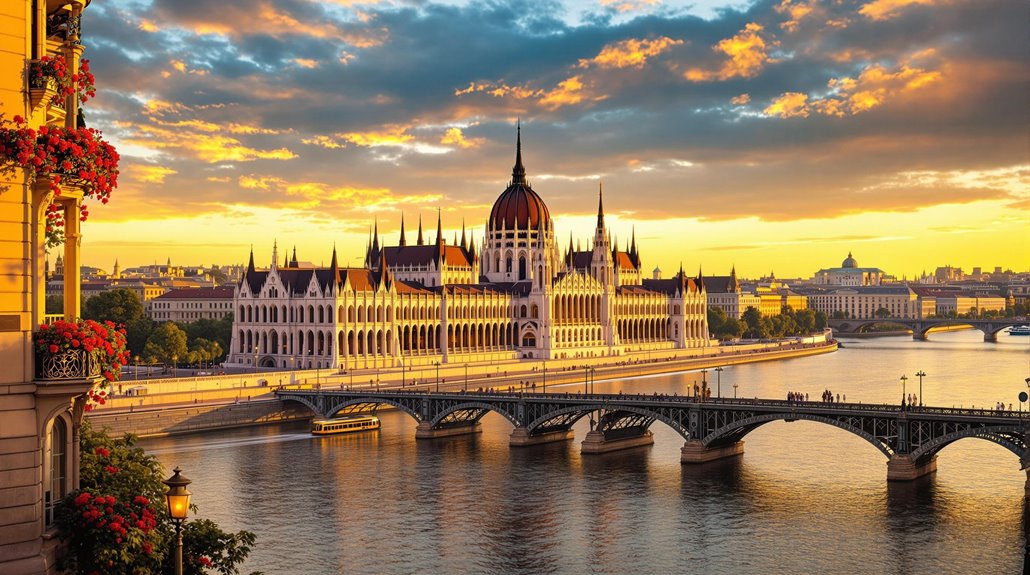
You'll discover that Budapest isn't just another European capital – it's a city that defies simple categorization. From its stunning architecture spanning centuries to its unique thermal bath culture, Hungary's crown jewel offers experiences you won't find anywhere else. Whether you're exploring medieval castles, relaxing in historic spas, or sampling local delicacies at traditional markets, Budapest's charm lies in its ability to surprise you at every turn. Let's explore what makes this city truly special.
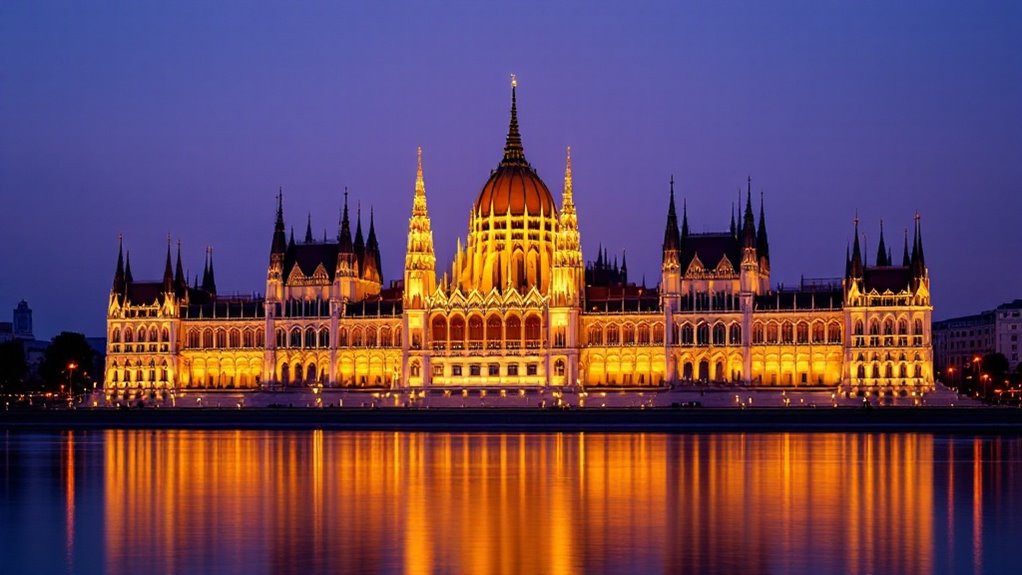
A crown jewel of European architecture, the Hungarian Parliament Building stands as Budapest's most iconic landmark.
You'll encounter this Neo-Gothic masterpiece stretching 268 meters along the Danube's banks, featuring a distinctive Renaissance Revival dome that reaches 96 meters high – a height symbolizing Hungary's founding year of 896 AD.
Built between 1885 and 1904, the structure's symmetrical design includes two identical parliamentary halls, while its exterior showcases a fascinating blend of Gothic, Arabic, Moorish, and Baroque influences.
The building's statistics are staggering: 40 million bricks, 500,000 precious stones, and 40 kg of gold went into its construction.
The sheer grandeur of Budapest's Parliament transcends numbers: millions of bricks, countless jewels, and pure gold create architectural perfection.
Inside, you'll discover 691 rooms, 29 staircases, and the medieval Holy Crown of Hungary, displayed since 2000. Tragically, the building's visionary architect Imre Steindl went blind and passed away before seeing his masterpiece completed.
While many European cities boast remarkable attractions, Budapest's thermal bath culture sets it apart as a true wellness paradise.
You'll discover over 125 thermal springs beneath the city, producing 70 million liters of mineral-rich water daily. These waters, reaching temperatures up to 77°C, have drawn visitors since Roman times.
You can choose from diverse bathing experiences across iconic facilities. The Neo-Baroque Széchenyi spans 6,220 m² with 18 pools, while Gellért showcases stunning Art Nouveau mosaics. Most baths enforce strict visitor etiquette requiring guests to shower before entering pools and maintain respectful noise levels.
The Ottoman-era Rudas and Király baths preserve authentic 16th-century Turkish architecture. Whether you're seeking medical treatments, joining locals for morning chess in outdoor pools, or attending lively nighttime "sparties," these historic baths seamlessly blend wellness traditions with modern amenities.
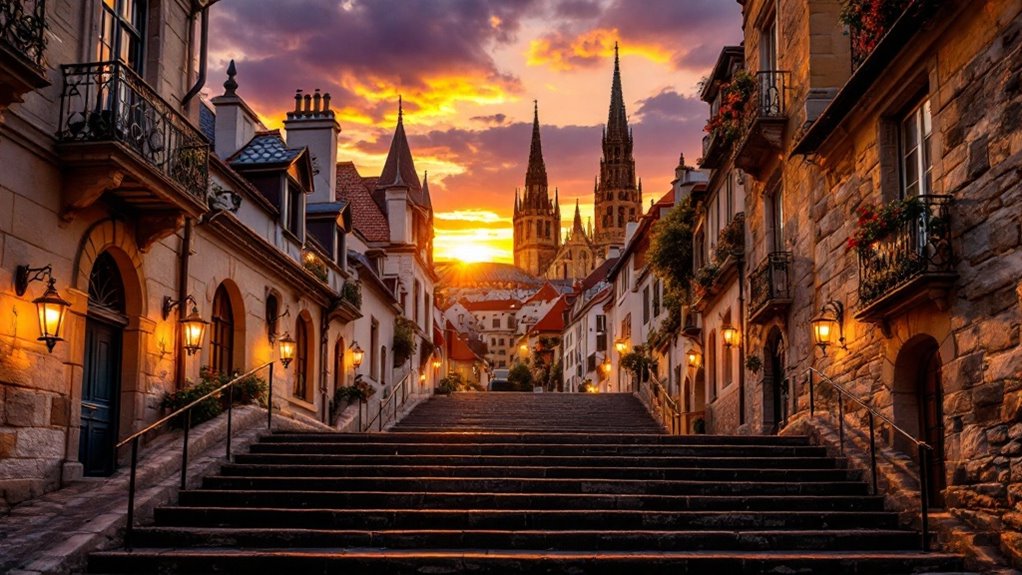
Perched 500 feet above the Danube River, Castle Hill stands as Budapest's medieval crown jewel and a tribute to Hungary's turbulent history.
You'll encounter a fascinating blend of Gothic, Renaissance, and Baroque architecture, with remnants dating back to King Béla IV's 13th-century fortress built to repel Mongol invasions. The castle underwent extensive Baroque style reconstruction beginning in 1715, marking a new era in its architectural evolution.
As you explore, you'll uncover Stephen's Tower's medieval foundations, Renaissance marble balustrades, and the iconic Matthias Church where Hungarian kings were crowned.
The Fishermen's Bastion's seven towers offer breathtaking views across the Danube.
Today, you can visit the Hungarian National Gallery, Budapest History Museum, and National Széchényi Library housed within the complex.
Don't miss the historic Castle Hill Funicular, connecting the site to the Chain Bridge since 1870.
Standing majestically across the Danube River, the Chain Bridge serves as a living symbol to Budapest's transformation from two distinct cities into one unified capital.
When it opened in 1849, it was the first permanent bridge connecting Buda's aristocratic hillside with Pest's bustling commercial district, replacing unreliable seasonal ferries. The bridge's impressive 202-meter center span made it one of the largest engineering achievements of its time.
The Chain Bridge marked a historic union, linking Buda's noble hills to Pest's vibrant markets through Hungary's first permanent Danube crossing.
You will discover yourself walking across a structure that survived remarkable history. Though German forces destroyed it in 1944, leaving only the iconic stone lions and abutments, the bridge rose again in 1949 using the original design.
Today, it's more than just a way to cross the river – it's where you'll see breathtaking views of the Parliament building and Buda Castle. At night, the illuminated bridge creates a spectacular sight that captures the spirit of modern Budapest's beauty and resilience.
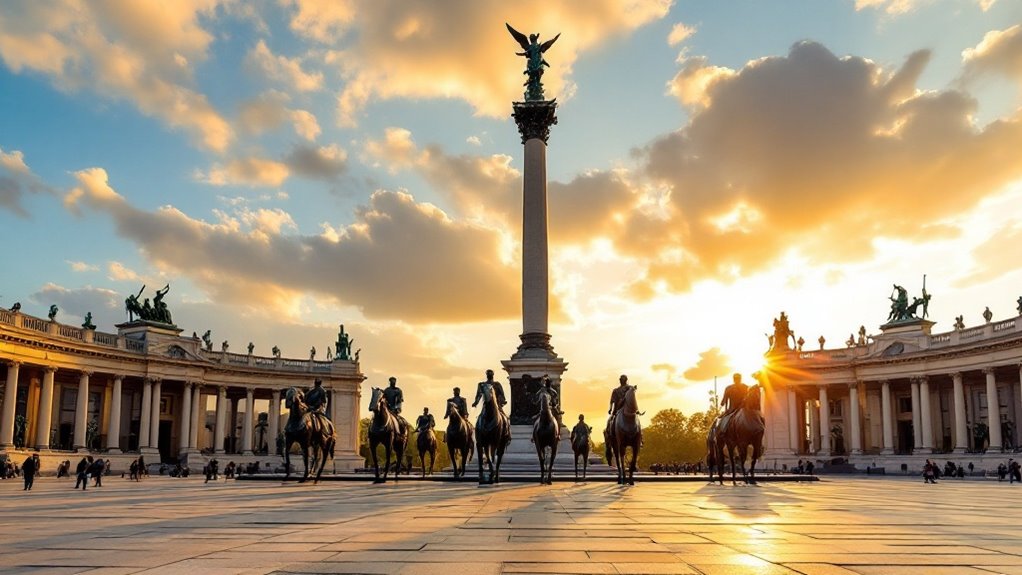
A monumental tribute to Hungary's founding fathers dominates Heroes' Square, one of Budapest's most significant landmarks. Commissioned in 1896 to celebrate Hungary's millennium, the square features a towering 36-meter column crowned by Archangel Gabriel holding St. Stephen's Holy Crown.
You'll find seven Magyar chieftain statues at the column's base, commemorating the tribal leaders who established Hungary in 896 AD. The impressive square spans 4,850 square meters and originally served as the grand entrance to the historic Millennium Exhibition.
Two sweeping colonnades showcase important Hungarian leaders throughout history, though most of the original Habsburg statues were replaced after World War II.
The square isn't just about history – it's still very much alive today. As part of the UNESCO World Heritage site along Andrássy Avenue, it hosts concerts, festivals, and public gatherings while serving as the grand entrance to City Park.
While Heroes' Square celebrates Hungary's history above ground, Budapest's pioneering spirit runs deep beneath the city streets.
The city's metro system, opened in 1896, was continental Europe's first underground electric railway and the world's second-oldest after London's Underground.
Pioneering beneath Budapest's streets, Europe's first metro system broke new ground in 1896, following London's revolutionary Underground.
You'll find remarkable innovations in this UNESCO World Heritage site, known locally as "kisföldalatti." It introduced the first bidirectional electric motor carriages and overhead wire power systems, influencing metro designs worldwide.
The original route connected Vörösmarty tér to Széchenyi fürdő with ornate stations that matched Andrássy Avenue's elegance above. The ambitious project was completed in under two years by 2,000 workers using the cut-and-cover method.
Though modernized in the 1970s with new trains and extended routes, the system preserves its historical charm.
Today, you can explore this engineering marvel at the Underground Railway Museum at Deák Ferenc tér.
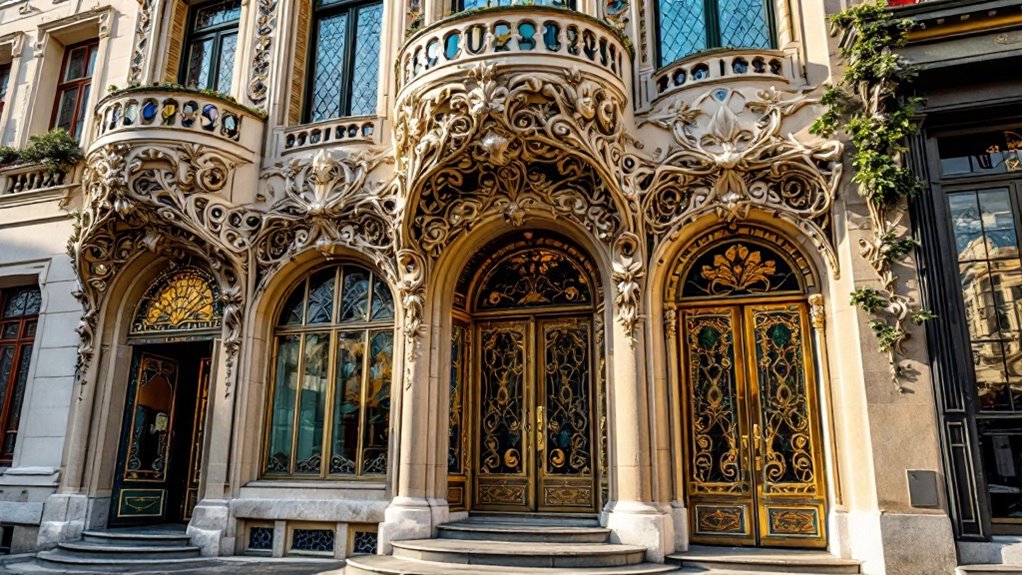
Budapest's Art Nouveau heritage shines through its remarkable collection of early 20th-century buildings.
You'll find stunning examples like the Bedő House, built in 1903, with its distinctive Hungarian folk motifs and Zsolnay ceramic decorations.
The magnificent Gresham Palace, now a Four Seasons Hotel, showcases Venetian mosaics and Miksa Róth's masterful glasswork.
At the Royal Postal Savings Bank, Ödön Lechner's innovative design features symbolic beehives and ceramic snakes on its roof, exemplifying the Hungarian Szecesszió style.
Don't miss the Turkish Bank House, where Béla Lajta brilliantly merged Art Nouveau curves with Ottoman patterns.
Each building tells a unique story through its architectural details, from the intricate stained-glass windows to the decorative ceramics that make Budapest's Art Nouveau landmarks truly special. The movement emerged as artists sought originality and organic designs, breaking away from historical architectural styles.
From the urban ashes of neglected post-war buildings, Budapest's ruin bars have transformed the city's Jewish Quarter into a lively cultural phenomenon.
You'll discover these eclectic venues housed in abandoned WWII and Soviet-era structures, pioneered by Szimpla Kert in 2004.
Step inside, and you're greeted by mismatched flea market furniture, graffiti-covered walls, and exposed architectural elements that proudly display their decay.
Each venue offers its own unique experience – from Instant-Fogas's 18-room EDM complex to Mazel Tov's upscale glass-roofed atrium serving Middle Eastern cuisine.
These spaces aren't just nightlife destinations. The bars actively foster artistic expression through their diverse cultural programming.
You can explore farmers' markets, watch films, or join book clubs during daylight hours.
While newer venues embrace more polished designs, they maintain the creative spirit that's made ruin bars a symbol of Budapest's post-communist renaissance.
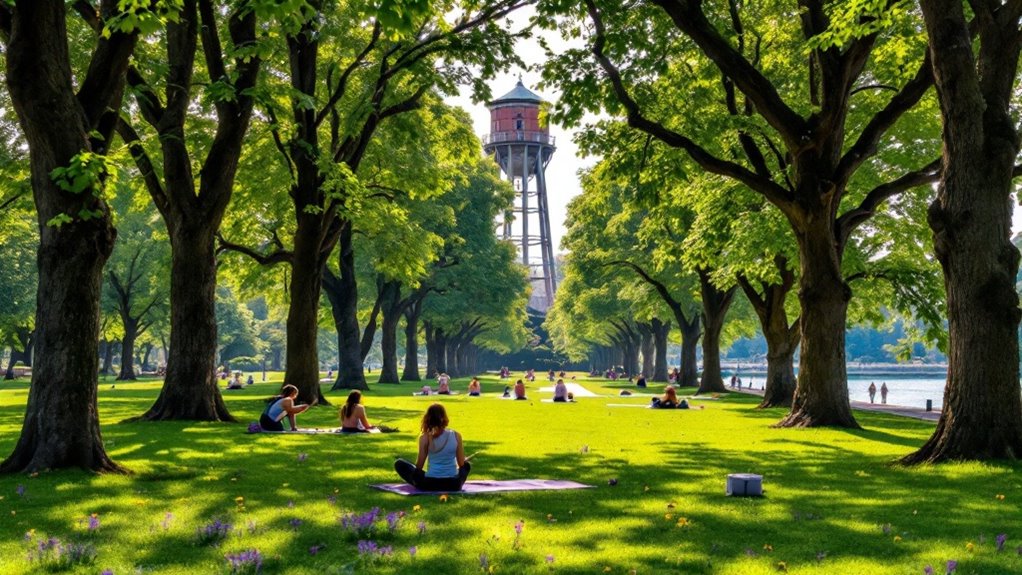
Nestled between Buda and Pest in the Danube River, Margaret Island serves as a lush 238-acre escape from the city's urban bustle.
You'll discover centuries of history here, from medieval ruins to a UNESCO-protected Art Nouveau Water Tower, alongside modern attractions like the Palatinus Water Park with its 11 pools. The island was originally known as Insula leporum, meaning Island of Rabbits, before being renamed in the 14th century.
The island's packed with activities: you can jog on the 5.35 km rubber track, explore the Japanese Garden's waterfalls, or catch a show at the open-air theater.
Don't miss the Music Fountain's hourly performances or the Rose Garden's 100+ species.
You can't bring your car, but you've got options – hop on bus 26, rent a bike for 990 HUF per hour, or take the tourist train.
The island's also home to thermal spas and sports facilities, making it a perfect blend of recreation and relaxation.
A paradise for food lovers, the Great Market Hall stands as Budapest's largest and oldest indoor market. Built in 1897, this neo-Gothic masterpiece spans three floors of culinary treasures, where you'll discover everything from fresh produce to traditional Hungarian delicacies.
With over 180 stalls offering an incredible variety of goods, the market buzzes with local vendors and excited shoppers daily.
You can't miss these market highlights:
Whether you're sampling horse salami, sipping Tokaji wine, or photographing the stunning Zsolnay tile roof, you'll experience both a feast for your taste buds and a glimpse into Hungarian food heritage.
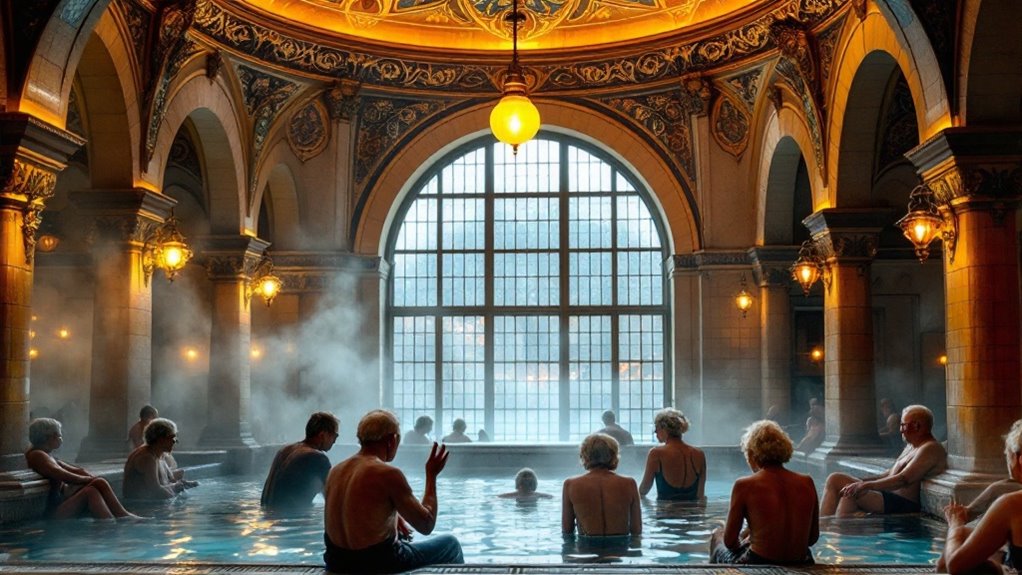
While Budapest's culinary heritage captivates visitors at the Great Market Hall, the city's intellectual legacy has transformed modern life as it's understood.
You're probably using Hungarian innovations daily without realizing it. When you write with a ballpoint pen, solve a Rubik's Cube, or create a Prezi presentation, you're experiencing Hungarian ingenuity firsthand.
The impact runs deeper into critical fields. The mRNA technology behind COVID-19 vaccines, developed by Katalin Karikó, showcases Hungary's continuing medical breakthroughs. Albert Szent-Györgyi's discovery of vitamin C in paprika revolutionized our understanding of nutrition.
Hungarian scientific genius shines through Katalin Karikó's groundbreaking mRNA research, revolutionizing vaccine development and modern medicine.
John von Neumann's computer architecture principles and Charles Simonyi's work on Microsoft Word and Excel have shaped how you interact with technology.
From László Bíró's smudge-free pen to Dennis Gabor's holography, Hungarian inventors have quietly revolutionized everything from simple writing tools to complex 3D imaging systems. The city's charming architecture reflects this spirit of innovation, blending historical grandeur with modern ingenuity.
Budapest's UNESCO World Heritage sites span an impressive 60 hectares along the Danube, featuring architectural marvels from Gothic to Baroque periods.
You'll discover centuries of history preserved in stunning landmarks, from the Neo-Gothic Parliament Building to the Classical Chain Bridge. The city's thermal bath culture adds another layer of distinction, with ancient facilities still in active use today. The Castle District and embankments gained UNESCO recognition in 1987, marking a significant milestone in preserving the city's heritage.
Key UNESCO-protected highlights include:
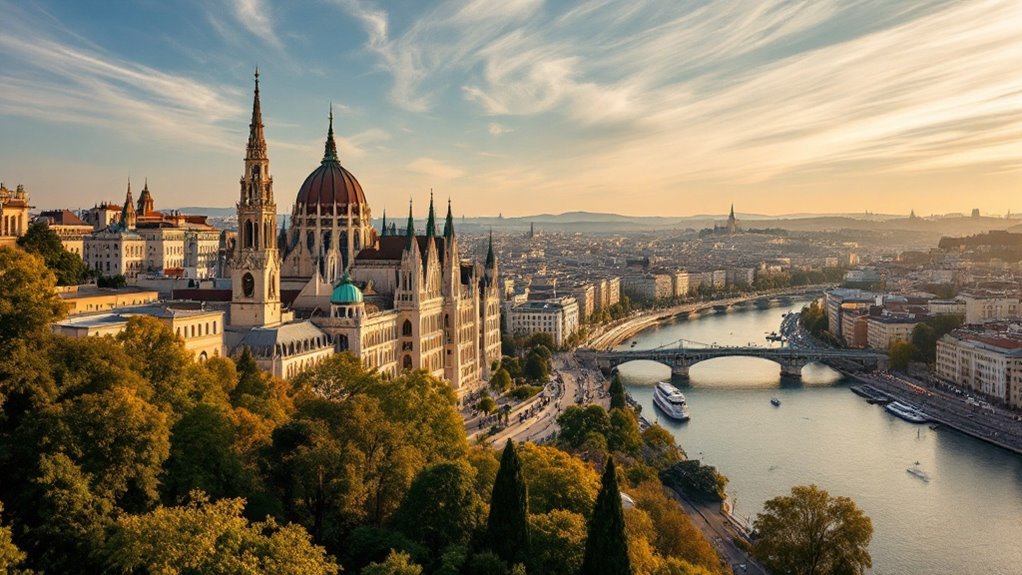
Beyond its UNESCO treasures, the architectural legacy of Budapest spans nearly two millennia, telling a rich story of conquest, culture, and artistic evolution.
You'll discover ancient Roman ruins at Aquincum, where a military amphitheater once held 12,000 spectators, alongside Gothic masterpieces like Matthias Church with its distinctive diamond-tile roof.
The city's style shifts dramatically through time – from Renaissance elements at Buda Castle to Ottoman-era thermal baths and the ornate Baroque flourishes of St. Anna Church.
The unification of Buda, Óbuda, and Pest into modern Budapest in 1873 sparked an architectural renaissance in the region.
The 19th century brought grand eclecticism, exemplified by the Neo-Gothic Parliament Building and Neo-Renaissance mansions along Andrássy Avenue.
The early 1900s saw Art Nouveau innovations emerge, with the Gellért Hotel's stained glass domes and the Museum of Applied Arts' Islamic-inspired designs marking Budapest's artistic independence.
Budapest's got everything you're looking for in a European capital. You will discover stunning architecture, rich history, and modern attractions all in one place. Whether you're soaking in thermal baths, exploring ancient castles, or sampling local cuisine at the Great Market Hall, the city delivers unique experiences. From UNESCO sites to innovative Hungarian contributions, Budapest proves it's a destination that seamlessly blends past and present.